A Book Review:
Life works in mysterious ways. I know this sounds cliche, but it’s also true. At a moment, where I was struggling with a sweater, for my daughter Hannah, a book was given to me, in which the author describes her struggle knitting a sweater for her son. Why should we care about that?
Because to my surprise it turned out to be much more than that. It’s not just about the sweater, but the author reminded me, that what we as knitters, or crafters in general are doing, is nothing but continuing, what women before us, have done throughout time. Nora Murphy, as a mother, and beginning knitter grabbed my attention with her personal stories, while guiding me through history, and traditions from all over the world. We are not the first knitters, and hopefully will not be the last ones, which she makes clear with a tangible link to our past.
Although it might not be important to many, as a visual person, I find the cover (design by Tracy Pitts) speaks strongly to me. Before I started reading it, I had the book lying around, waiting to be read, and as I walked by I would brush my fingers over it.
Knitting the Threads of Time
by Nora Murphy
A woman sits in her comfy chair. Two needles and a ball of yarn keep her company. She’s knitting away at something. Maybe a scarf? Socks? She enjoys the sound of her needles beating like a soft drum. She inhales the smell of the waxy yarn. She exhales the satisfaction of watching a single strand transform into an object of beauty. She is perfectly present, in perfect bliss.
This is not a revolutionary act. It is not a moment to record in the history books. All the same, this woman is a revolutionary. She, and millions of women around the globe like her, are making history in their homes. They are creating clothing for loved ones. They are the grandmother who knits a Christmas stocking for her grandchild, the young mother who stitches a star quilt to honor an elder, the two seventh graders who crochet a baby blanket for a teacher’s newborn.
Their craft often has to be wedged into the harried schedules and nonstop demands of modern life. The grandmother knits in the hospital waiting room while she awaits the results of her husband’s surgery, his third. The young mother penny-pinches time and money to piece together the dozens of diamonds that will become a star. The preteens’ work competes with homework, pimples, and text messages from boys they haven’t yet kissed.
What these modern artists often don’t see are the remnants of an ancient lineage to which they belong. The grandmother, the young mother, and the girls are all descendants of the women around the globe who have transformed fibers into clothing to protect their families for tens of thousands of years. They are the heirs to goddesses who understood that human survival depends on the cloth. These ancients — from China to Egypt, from Peru to the Pacific Northwest — understood that clothing contains the power of creation. The modern knitter is no different. She too, replicates the act of creation; she too keeps the child, the clan, the community alive.
In North America, most of today’s needle artists don’t have to worry that our children will go cold if we don’t finish the sock, the quilt, or the blanket. We have the luxury of buying most of our clothes at big chain stores at the local mall. - continued -
We choose freely to make garments. Yet by this choice, contemporary crafters keep the ancient tradition going — a tradition that reminds us of our primal existence on this precious earth, that reminds us where we’ve come from and who we are.
Inside a stitch, just a single knitted stitch, lies the paradox of the ordinary, everyday textile hero. Her simple stitch helps keep the story of humanity alive; her work casts on stitches for the next generation.
I am a modern-day knitter, though I admit this hesitantly. The domestic sciences have never been my strong suit. I nearly flunked home economics in high school. We started with cooking, but my assignments resulted in burned objects destined more often for the trash can than the table. I didn’t fare much better when we started sewing. I loved the idea of making my own clothes, but I couldn’t figure out how to thread the bobbin without swearing or slicing my finger. I couldn’t cut fabric on the bias. Lacking domestic skills didn’t much matter until I had children of my own — children who need three meals a day, every day, who need clothes to keep them warm in the long winter months.
Despite my domestic demerits, I’m the one in charge of my household, which includes middle schooler Andrew, first grader Evan, and my partner and the boys’ good friend, Diego. Everyone pitches in: Evan takes out the recycling, Andrew cleans the downstairs bathroom, Diego folds the laundry. Still, under my management, the house is often cluttered, and dinner rarely gets four stars. There’s just one domestic art that doesn’t stump me — knitting. It’s not that I’m very good at it. It just doesn’t scare me the way cooking and cleaning do.
Last winter I managed to make wool socks for Evan and Andrew. It had been years since I had knit. I was surprised that none of the basic dance steps with the yarn and two knitting needles had left me. I remembered how to cast on, knit, purl, and bind off without having to think — a bicycle kind of thing. Plus knitting, unlike sewing, has no bias. Knitting welcomes everyone, and the yarn goes any direction you tell it to.
Nora Murphy is a freelance writer who specializes in writing for nonprofit organizations in the urban communities in Minneapolis and St. Paul. Her stories and essays have appeared in such places as the anthology Twelve Branches (Coffee House Press, 2003). She holds an MFA degree in writing from Hamline University. She lives in St. Paul.
From the book, Knitting the Threads of Time © Copyright 2009 by Nora Murphy. Reprinted with permission from New World Library. http://www.newworldlibrary.com/ or 800-972-6657 ext. 52
Contact: Monique Muhlenkamp
New World Library
800-972-6657 ext. 15
Monique@newworldlibrary.com
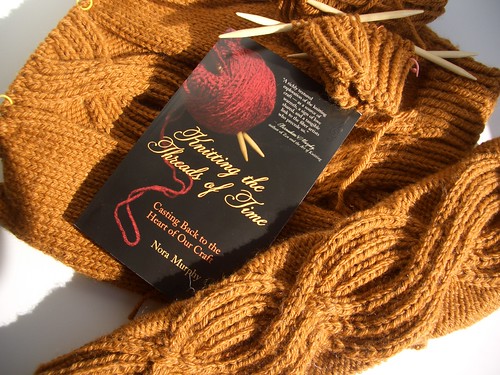
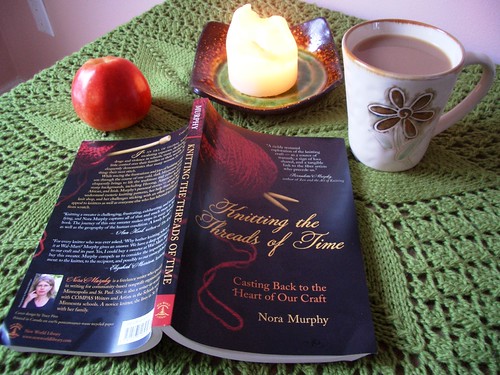








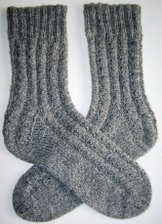
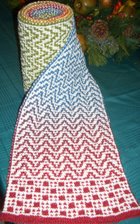
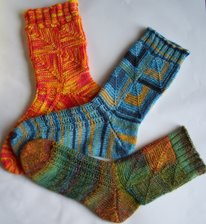





12 comments:
Thanks for sharing the review. It is nice to have new fodder for my reading queue.....almost as long as my Ravelry queue.
nice photo composure, Monika.
p.s. We met when I saw your Braided Shawl which I still covet.
Sounds like a very interesting book. I love it when a writer writes about things that I myself have experienced.
I don't like cooking or cleaning either, mainly because I'm not very good at it, but I should probably give myself some credit since my son is alive and well fed!
And knitting I know, have known, will always know and have passed it on as a volunteer knitting teacher at my local library.
Great review - it has piqued my interest - now I'll have to read the book. And yes, the cover, so important, is lovely. Thanks, Monika.
Thank you! The review is great, certainly makes me want to read it! Thanks for sharing. I was and am not the best cook.. I am not big on cooking... I found my home making ground with the sewing machines(in high school), and crochet before them... and knitting after :)
Excellent review. Thanks so much for showing us this book. So much wisdom and history. Nice to be a part of it.
Wow, Monika, that book must have really moved you, I'll have to get myself a copy.
I'm off to get a copy,,, Green place mat is beautiful, Judy from Alaska ~~~ Soooo very glad your back,,,
Thank you so much for this review, I'll definitely be keeping my eye out for this book!
Sounds like a good book.
Another one to put on my to read list ;)
Nora Murphy will be at Borealis Yarns in St. Paul on Monday, Feb 16 in case you're all interested!
What an interesting sounding book. I'm not sure I've ever given much thought to why I knit and those who have knit before me - other than my mother and paternal grandmother who I actually saw engaged in the craft. It's complex because today we can buy clothing ~ yet so many of us still chose to knit and I must give some thought to why I do it.
Nice blog. I think this is a lovely book to read. Let's see if it is available in The Netherlands.
Post a Comment